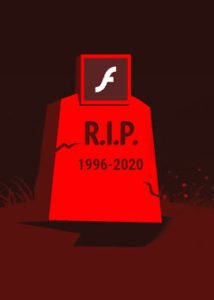Read more to find out why your Flash-based Legacy e-Learning courses are giving your learners headaches, exposing your LMS to security vulnerabilities, and reducing the effectiveness of your employee education and training.
Adobe is Killing Flash at the end of 2020 – exposing remaining Flash content to even greater security risks
In April 2010 Steve Jobs, in his ‘Thoughts on Flash’ memo, declared Flash obsolete for a host of reasons, including reliability, security, performance, battery life, and that Flash is proprietary 3rd party software subject to the whims of Adobe. Apple subsequently declined to allow Flash on iPhones and iPads. Jobs concluded in his characteristically blunt style:
Flash was created during the PC era – for PCs and mice. […] But the mobile era is about low power devices, touch interfaces and open web standards – all areas where Flash falls short. […] New open standards created in the mobile era, such as HTML5, will win on mobile devices (and PCs too). Perhaps Adobe should focus more on creating great HTML5 tools for the future, and less on criticizing Apple for leaving the past behind.
In an effort to stem hacking vulnerabilities and leave behind Flash’s buggy problems, all of the major tech giants have followed suit. Flash is now blocked by default (without special permission) in Firefox, Google Chrome, and on Facebook. In late 2015 Adobe itself encouraged “content creators to build with new web standards,” and in mid-2017 Adobe announced that they “will stop updating and distributing the Flash Player at the end of 2020.” This means that any of your Learning Management System’s current Flash vulnerabilities will become all the more critical, come 2020.

Photo credit: hackernews.com
Flash requires a plugin, whereas HTML5 does not
If a learner tries to play Flash-based e-learning content on a browser that does not have the Flash plugin–or doesn’t have it enabled–all they will see is a black box (which may or may not indicate that they need the Adobe Flash Player plugin to see it). HTML5, on the other hand, does not require a plugin to function on nearly any device. Even older browsers (which may limit some features of html5) should still be able to play most HTML5 content. And, according to elearningindustry.com,“Flash needs more processing power and, as a result, the speed at which the content is delivered is reduced.”

Your legacy e-Courses do not function on your employee’s mobile devices
Flash is not supported on Apple and Android devices–which means they only see a black box: And that means that your learners cannot access your legacy e-Learning content on their mobile devices. They don’t have the option to knock out an e-Course during their train, bus, or carpool commute; instead they must complete it at their workstation.

Think your e-Learning is already dual-compatible? Think again.
You may have already done some e-Course upgrades for dual HTML5/Flash compatibility using Articulate Studio 2013 or similar recent–yet already outdated–products. HTML5 has come a long way in the years since then–and so has the e-Learning authoring software. The Articulate 2013 products were more stopgap measures to provide dual HTML5 and Flash compatibility that produced lower quality visuals and, in the case of Presenter 2013, caused many popular animations to default to ‘appear’ in HTML5. A simple upgrade in the new Articulate Studio 360 can already greatly increase image quality, smoothness, and allow many more animations (that previously only functioned in Flash) to work extremely well–and that is before you factor in our ability to make further enhancements to the content. The newest software also creates content with a responsive mobile player that is far superior for mobile learning.

Mobile learning is on the rise
More and more organizations are discovering the advantages of mobile learning (AKA ‘mLearning’). One major factor driving the shift toward mobile learning is the retirement of Baby Boomers and the rise of Millenials in the workplace. Many Millenials simply prefer to learn on their mobile devices. Have a look at this article about all of the benefits mobile learning can impart to your training program.
HTML5 is the future for e-Learning
The issues listed above demonstrate that HTML5 is the future for e-Learning–and all interactive visual content on the web. For this reason, Vetter Solutions now designs and tests all new e-Courses for HTML5 publication. We also routinely help our new and existing customers to translate their Flash-based legacy courses to the responsive HTML5 format. Sometimes, certain client’s needs still require their e-learning to function in a Flash environment. For cases like this we can publish using both methods.

Preparing our clients for the Flash to HTML5 transition
We know the pitfalls
Vetter Solutions has done extensive research and testing to help you avoid the hiccups in this transition. We know what animations work and in which browsers: inconsistencies in certain animations and functions between Flash and HTML5 output can cause problems ranging from minor to unacceptable. We know what to do to avoid them until HTML5 becomes fully developed on all major browsers. (Let’s face it: Internet Explorer has been behind the curve for a long time now.)
Prepared for the future
We now design and test all new courses for HTML5 publication. Even if your company’s hardware and software setup still needs Flash for now, we can also publish every new or updated course in both formats, so you get the best of both worlds.
Ready to Upgrade — with Next Generation e-Learning Software
Vetter Solutions is experienced in converting courses that were created in Articulate with Flash (or HTML5) to the new version of Articulate 360 (Presenter and Storyline) with HTML5, which is much less buggy and produces higher quality graphics than the previous versions. For example, even the 2013 releases of Articulate Presenter and Articulate Storyline were capable of producing HTML5 e-Courses; but with the tradeoff of markedly degraded images and choppier transitions versus the Flash version. The new Articulate 360 software suite is greatly improved with regard to the resolution and smoothness of its HTML5 output. The new software also integrates a fully responsive player for smaller-screen mobile devices that makes viewing and navigating courses on smartphones and tablets much easier and more enjoyable than before!
The case for publishing content in both HTML5 and Flash (for now)
It is true that there are still a few areas where Flash slightly outperforms, however HTML5 has already mostly caught up and will eventually outshine Flash. There is one reason that it may still make sense to publish your organization’s e-Learning material with Flash in addition to HTML5: If the computers your learners work on are older, for example running Windows XP with Internet Explorer 8 or 9, they may not be able to view the best version of a course in HTML5. In such cases it makes sense to also publish the course in both formats and specify which version is preferred. An Articulate staff member puts it this way:
“It may be shocking to hear, but some users still rely on older browsers which are capable of playing HTML5, but won’t play it to the same standard as an updated browser such as Chrome. In those scenarios if you published for HTML5 first/Flash fall back – the course would play but not well. So those users can publish for Flash first/HTML5 fall back and users who view it in a browser such as IE8 will still have a great experience.”
If you are familiar with Articulate courses, here is a good table that clearly lays out all of the differences between Flash and HTML5 exports in Articulate Storyline 360.
An excellent opportunity to upgrade your CONTENT as well
Flash to HTML5 upgrades to exiting courses provides an excellent opportunity to also upgrade their content. There are multiple reasons it’s in your best interest to use this opportunity to upgrade the content of your legacy e-Courses:
- Your company’s or greater industry’s standards and benchmarks may have changed.
- Equipment, tools, and products may have gone through their own upgrade cycles.
- Graphics and photos may date the course significantly. (00’s throwback, anyone?)
- Links to websites and other outside content may now be invalid.
When we perform course upgrades, we can help make sure that these easy fixes get updated if need be.

